UPDATE: UK Autodrive was the winner of the automotive category of The Engineer's 2018 Collaborate to Innovate Awards. Read about the other winning projects here.
An ambitious real-world trial on the streets of Coventry and Milton Keynes is helping to put the UK at the forefront of driverless and connected car technology. Jon Excell reports.
The driver of the car stuck in front of us is getting angry. If only we’d acknowledged his subtle blend of hand-gestures and nods, done the decent thing and backed up a couple of metres, he could have performed his illegal (although not particularly dangerous) U-turn and been on his way. But we don’t budge. And no amount of gesticulating is going to persuade us to. That’s because our driver isn’t like most drivers. Our driver is a robot. And robots like to stick to the rules, even if it means annoying their fellow road users.
And as he screeches off into the Milton Keynes rush-hour, his parting expletive ringing in our ears, our furious fellow-traveller leaves us with an illuminating reminder that while driverless car technology may be advancing rapidly, smoothly integrating it into society is another challenge altogether.
Overcoming obstacles like this is one of the remits of the Autodrive project: the UK’s largest ever trial of connected and autonomous vehicle technology; and the reason The Engineer finds itself being chauffeured around Milton Keynes’ famed grid system in a driverless Range Rover.
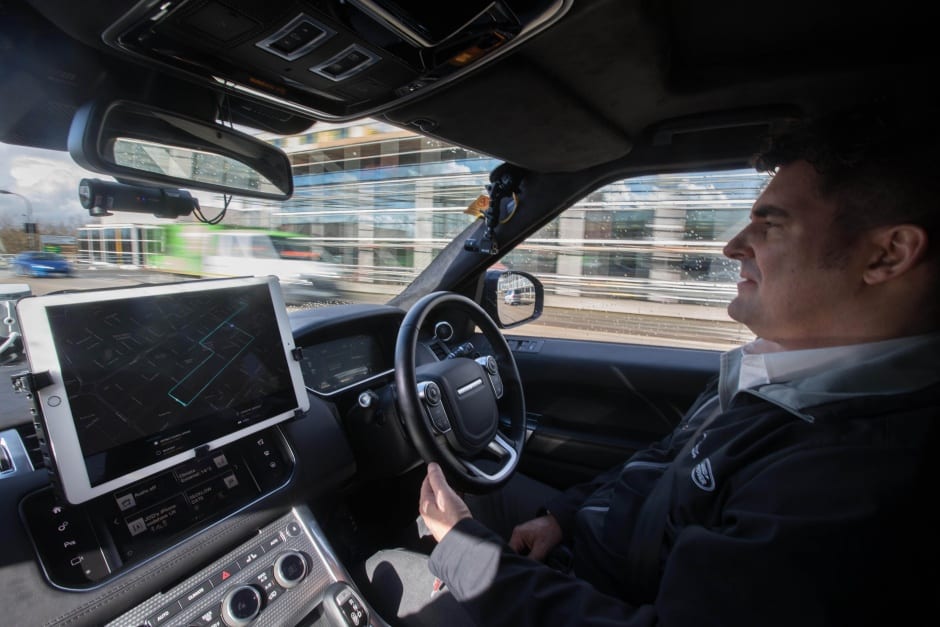
Led by engineering consultancy Arup, and involving a diverse mix of car-makers, local councils, academic research groups and even experts from the worlds of insurance and law, the project – which was launched three years ago in response to a government “driverless cars competition” – is aimed at preparing society for driverless cars and positioning the UK as a hub of connected and autonomous vehicle expertise.
Over the course of the last three years the project partners – who include JLR, Ford, Tata, MIRA HORIBA, the universities of Cambridge and Oxford, and a host of other specialists - have demonstrated a range of technologies both on the test track and on the streets of Milton Keynes and Coventry.
Meanwhile in the centre of Milton Keynes, as the project enters its final phase, a fleet of 40 driverless pods, developed by Coventry firm RDM group, are being used to explore how autonomous vehicles (summoned by smartphone) might operate safely alongside pedestrians and reshape so-called “first and last mile” transportation.
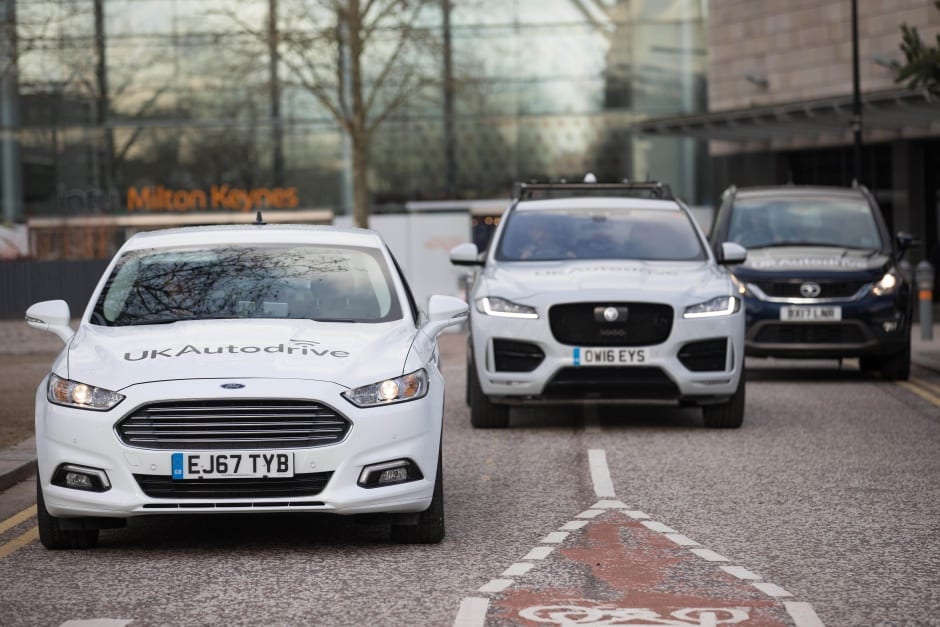
The Engineer’s visit earlier this summer coincided with a series of public road trials including demonstrations of the vehicle described above: a prototype Range Rover capable of Level 4 autonomy: meaning it is theoretically able to perform all safety-critical driving functions (see fact box below).
Equipped with a mix of lidar, radar and cameras, the vehicle was programmed to follow a pre-mapped route along public roads and had to cope with all of the unpredictability of a real-life traffic environment.
Reflecting on these trials, JLR autonomous vehicle research engineer Jim O’Donoghue told The Engineer that the vehicle has performed well in an environment that has proven to be an excellent test-bed for driverless technology. “The grid-like nature is great,” he said. “The traffic lights are great – each four entry and exit points get their own go so we’re not having to give way to traffic, which helps us out a bit. The dual carriageways are also an interesting element, as the car’s having to cope with a lot of information.”
Understanding autonomy
A widely accepted set of guidelines defined by The Society of Automotive Engineers (SAE) describes the differing levels of autonomy in driverless cars.
- Level 1 - Commonplace for a number of years, Level 1 enables a single element of the driving process to be taken over in isolation. Examples include lane-keep assist and adaptive cruise control.
- Level 2 - The current state of the art, this enables a car’s computer to take control of two or more elements (for instance steering and braking) at the same time.
- Level 3 - The next step. Capable of undertaking all driving functions under most conditions but may rely on a human driver as a fall-back system.
- Level 4 - Capable of autonomously performing all driving functions. Doesn’t rely on fall-back to a human driver and may or may not have driver controls. Restricted to operating within controlled, geo-fenced areas.
- Level 5 - The long-term dream. Is not geo-fenced and can perform all driving functions anytime and anywhere.
Alongside JLR’s demonstration, recent months have also seen trials of a range of closer-to-market applications for vehicle-to-vehicle connectivity technology based on DSRC (dedicated short-range communications) – a low-latency, high-speed wireless communications technology similar to Wi-Fi.
These included a demonstration of collaborative parking – in which connected vehicles update each other on the location of available parking spaces, and an Electronic Emergency Brake Light (EEBL) feature which gives a warning when another connected car further up the road brakes heavily – potentially giving drivers several additional seconds to avoid a possible collision. The project has also demonstrated a so-called Emergency Vehicle Warning (EVW) system, which displays information about where an emergency vehicle is before a driver can identify it with their ears and their eyes.
Clearly, technologies underpinned by connectivity in this way, cannot be developed in isolation and one of the defining characteristics of Autodrive is the degree of collaboration between companies that are more used to fierce competition with each other.
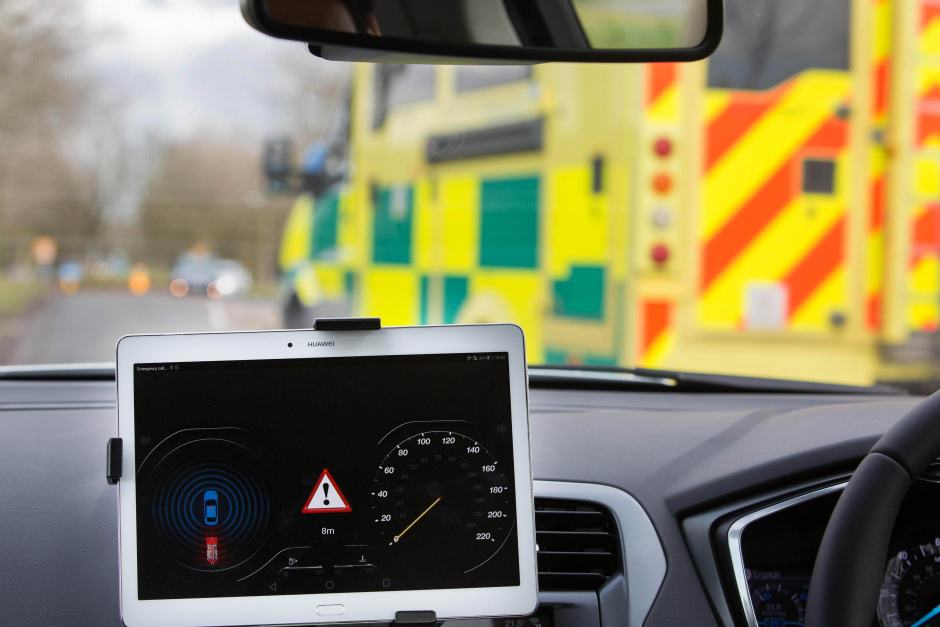
It is, remarked project leader Tim Armitage, of Arup, an unusual but essential dynamic. “In the brave world of connected and autonomous vehicles it’s not going to happen unless the vehicles are going to run collaboratively,” he said. “It’s no good if a Volvo only talks to other Volvos. There’s been a lot of effort to ensure that the systems on the vehicles are interoperable.”
Reiterating the importance of this cross-company collaboration, Dennis Witt, a research engineer with Autodrive partner Ford, said: “It’s been really useful testing with Jaguar and Tata. If we just tested three Fords together with the same hardware and software it would all work – it’s only when you get into that mixed environment that you can understand some of the interoperability challenges.”
In a sign of the way in which connectivity is blurring the boundaries between different disciplines and sectors, the project has also involved a number of firms not automatically associated with automotive. Arup itself is a good example of this. “We can see that connected and autonomous vehicles are going to affect everything we do as a business, from building design, road design, infrastructure design,” said Armitage. “It’s going to have a huge impact on all the things that we do as an engineering consultancy.”
Another key partner in this regard is security and transportation specialist Thales, which has been advising on cybersecurity measures for protecting data, and protecting connected vehicles from cyberattacks.
Cybercrime is a growing threat in almost every area of modern life. Indeed, recent government statistics found nearly half of all UK businesses suffered a cyberattack in the last year. But while the biggest threat in many areas is data-related, there’s a growing realisation that cyberattacks on cars could actually directly put lives at risk. “This is a cyber-physical system, so attacks are around things like trying to stop the brakes by denial of service, and not around standard information things,” explained Peter Davies, technical director at Thales e-Security.
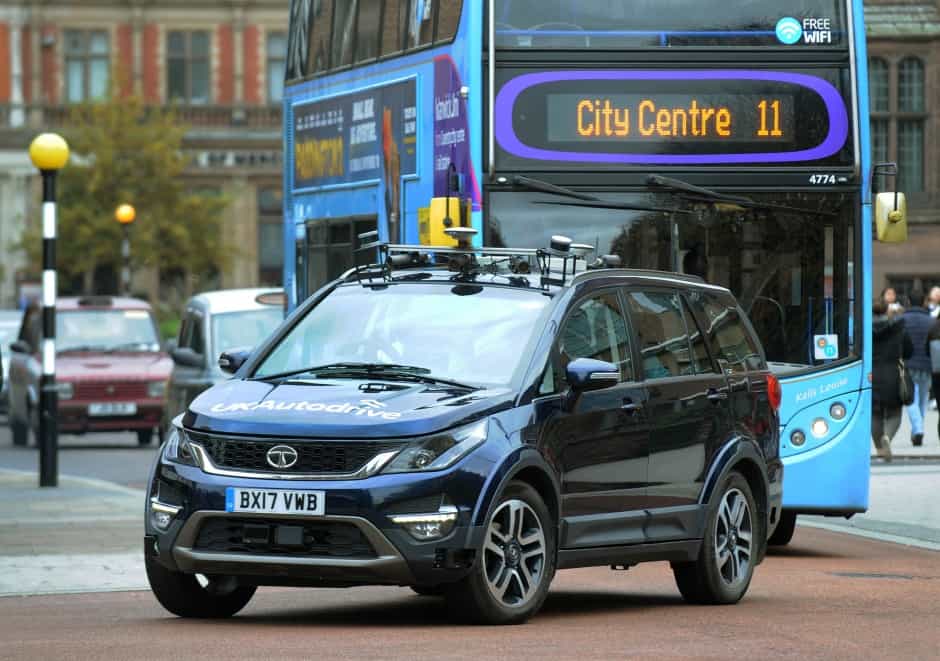
In terms of the technologies showcased through Autodrive, developing processes and methodologies for protecting pods is, said Davies, a more straightforward challenge than ensuring that high volumes of road-cars are hack-proof. “In many ways [the pod] is a public service vehicle so it’s much closer to things we do on the railways and elsewhere where it’s not owned by somebody,” he said, “but as you move into autonomous vehicles made by a multitude of different manufacturers those issues are far more problematic and outside the usual engineering experience.”
As a fast-paced global industry, which is more comfortable with change than most, Davies believes the car sector is well-placed to get to grips with this emerging threat. Nevertheless, the challenges it faces are exceptional. “It operates at scale, it’s mobile, it has to take liability for what it’s doing, it’s got personally identifiable and safety critical information, it’s a heterogeneous network that talks to satellites, roadside infrastructure. All of those elements are part of what they’re trying to consider. It’s a mind-bogglingly difficult set of things that they’re trying to do.”
And this is just one of a number of critical challenges that will be need to be addressed before the kind of Level 4 capabilities showcased by Autodrive enter the mainstream, including, said Armitage, making the technology affordable. “It’s not so much working out how to do the things we want to do,” he said, “but it’s a case of working out how we can do the things we want to do with hardware that’s at the level of cost you can put on a car.”
“This is not to decry what we’ve achieved,” he added, “but we’ve done it the easy way: we’ve thrown technology and sensors and processing power at the problem. If you open the boot of one of our cars you wouldn’t get your weekend case in there because it’s just full of tech and computers and electronics. Now the challenge is how do we replicate that functionality with more affordable sensors.”
Industry has been woefully inadequate in the way it has described driverless cars
Though these challenges are extreme, solving technical problems is at least familiar territory for engineers. However, industry is on slightly less comfortable ground when addressing the softer issues around public acceptance of the technology.
Armitage said that it needs to improve the way it talks about driverless cars. “Industry has been woefully inadequate in the way it has described driverless cars…for the most part there’s complete misunderstanding in the outside world of what an autonomous car is.”
Part of this, he said, is reminding the public that with most vehicles now boasting some form of driver assistance there are few vehicles on the roads that are not at least level 1 autonomous. “One of my pet lines in presentations is that if you want to know what an autonomous vehicle is, the car park outside is full of them.”
Pod squad: how Coventry’s RDM Group is shaping the exciting future of ‘first and last mile’ transport
The unassuming, scruffy-looking industrial estate from which it operates is an unlikely looking site for the birthplace of a transport revolution. But it’s entirely possible that in years to come Coventry’s RDM Group will be regarded as one of the pioneers in the world of ‘first and last mile’ transportation.
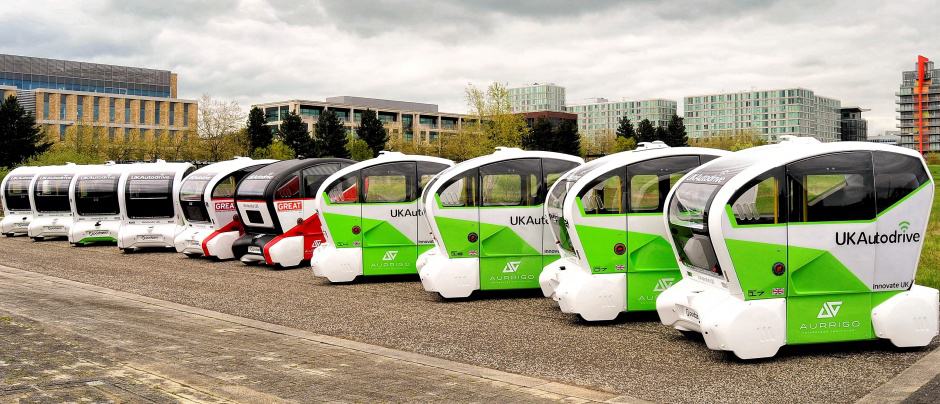
The company, which began life producing wiring harnesses for Jaguar Land Rover, has been making a name for itself in this emerging field, firstly with the development of a two-seater driverless pod for the Government’s Lutz pathfinder project, and more recently with the design and production of the fleet of four-seater autonomous pods currently being tested in pedestrianised areas of Milton Keynes as part of Autodrive.
With a top speed of 15mph, the distinctive-looking vehicles are powered by an easily swappable lead-acid battery pack with a life of up to eight hours. Explaining the decision not to use lithium-ion batteries, RDM’s chief designer Elliott Hawkins said that the ready availability of lead-acid batteries around the world, coupled with the low speed and range requirements of the pods, actually made lead-acid the logical choice. “It’s very weird to see a modern electric vehicle with lead-acid batteries, but we’ve used the limitations of lead-acid as a positive,” he said.
The pods are built on a steel space frame chassis. This is covered in a laser-cut aluminium super-structure, which is then clad in vacuum-formed body panels. In the interior, Hawkins has taken a number of design cues from public transport: such as high-vis seat edges from taxis, and yellow grab handles. “Although it’s an alien environment and autonomous you sort of feel at home because you’re picking up on other cues you’ve seen elsewhere,” he said.
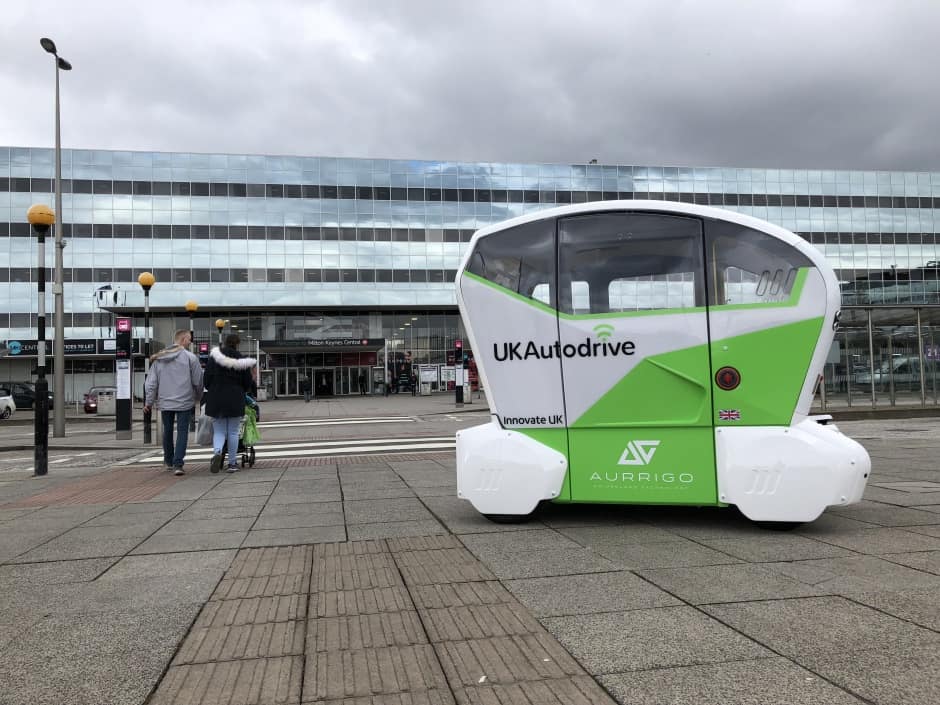
As well as the vehicle body, RDM has also developed the autonomous control systems and algorithms that interpret data from the Lidar, GPS, ultrasonic and video sensors dotted around the outside of the pod and enable it to safely navigate a crowded and unpredictable urban environment. These technologies are constantly refined and tested in the group’s Urban Development Laboratory – a facility it shares with JLR – where engineers are able to simulate and test a variety of different driving situations.
Unsurprisingly, when Autodrive’s pod trial was first proposed, the prospect of driverless cars trundling around pedestrian areas wasn’t universally well received. One particularly concerned group was Guide Dogs for the Blind, which feared that the pods would make a difficult environment even more hazardous.
Arup’s Tim Armitage said that dialogue the project had with the organisation was an interesting example of how quickly perceptions can be changed. “Within the space of a day we explained how the vehicles would sense people and respond accordingly, and by the end of the day they were totally sold on the idea,” he said.
The organisation has since been working with RDM to make the pods more accessible to partially sighted and blind people by introducing braille notices on the outside, choosing interior colours that can be detected by partial sighted people, and making them more dog friendly.
Alongside Autodrive, RDM is involved in a number of other projects including a collaborative effort with WMG to develop swarm intelligence systems for its pods and a proposal to produce a 40mph, 12-seater driverless bus that will operate along guided bus-lanes in Cambridge.
With a base in Australia, and a recently announced hook-up with Arup to gain a foothold in the US autonomous vehicles market, the firm is also exploring a number of international opportunities for its technology.




April 1886: the Brunkebergs tunnel
First ever example of a ground source heat pump?